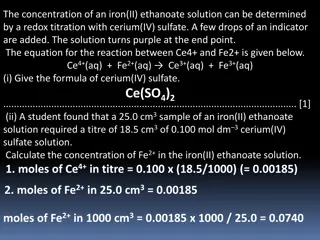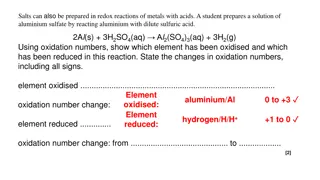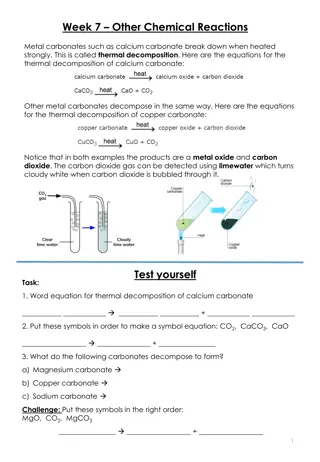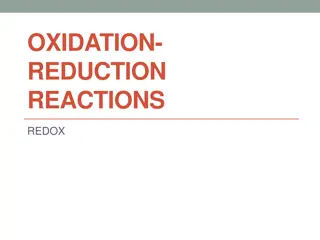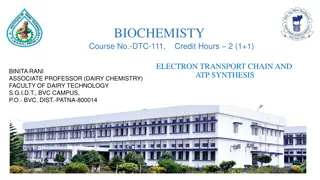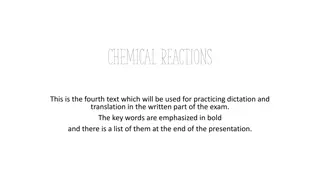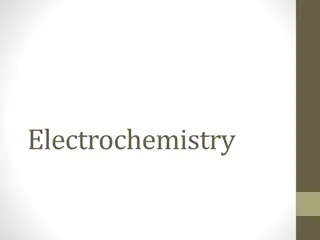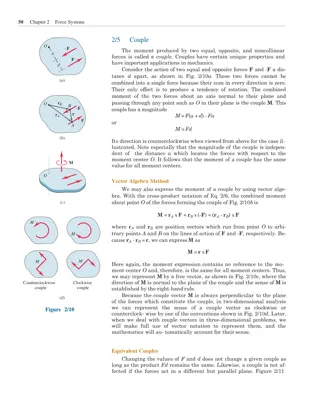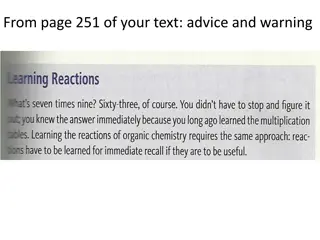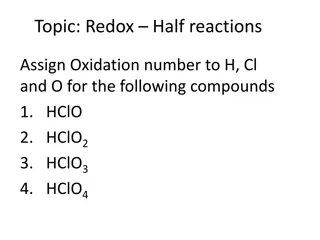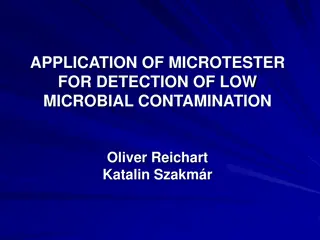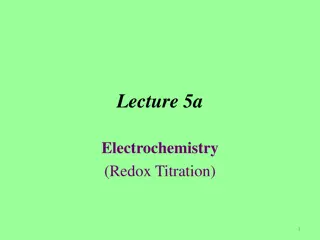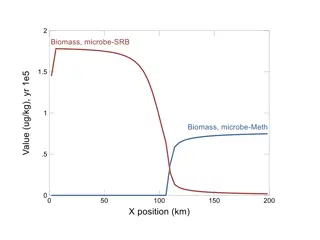Redox Couples Management: Creating & Modifying Reactions
Take control of redox reactions with this step-by-step guide. Learn how to make and break redox couples, adjust stoichiometric coefficients, and manage species in the reaction template. Explore the process of changing a basis species into a redox couple and vice versa, optimizing coupling reactions for efficiency and effectiveness.
Download Presentation

Please find below an Image/Link to download the presentation.
The content on the website is provided AS IS for your information and personal use only. It may not be sold, licensed, or shared on other websites without obtaining consent from the author.If you encounter any issues during the download, it is possible that the publisher has removed the file from their server.
You are allowed to download the files provided on this website for personal or commercial use, subject to the condition that they are used lawfully. All files are the property of their respective owners.
The content on the website is provided AS IS for your information and personal use only. It may not be sold, licensed, or shared on other websites without obtaining consent from the author.
E N D
Presentation Transcript
I-wen Su 3.0 The Work under the Creative Commons Taiwan 3.0 License of BY-NC-SA . CC CC 3.0 \\140.112.59.229\ \ \ \ ICON \ Creative Commens 2.5\ icon_by-nc-sa.tiff
Southern region of Fujian Province A dialect: Zhang1zhou1 Classified under the Quan2zhang1 Division in Chinese linguistics Southern region of Fujian Province A dialect: Hokkien Zhang1zhou1 - Hokkien or Quan2zhou1 Quan2zhou1 Quan2zhang1 Division in Chinese linguistics Wiki Luuva \\140.112.59.229\ \ \ \ ICON \ Creative Commens 2.5\ icon_by-sa.tiff
Min Nan Fulaohua Southern Min Min Nan ( ; Min3nan2hua4; B n-l m-o ) Fulaohua ( ; Fu2lao3hua4; H -l -o ) Southern Min T i a form of Hokkien spoken in Taiwan Holo/Hoklo, the main ethnicity of Taiwan, is the ethnic group for which Hokkien is considered the native language T i- -o n o n- -o o / : :
Overseas Chinese in Southeast Asia as well as in the United States Hokkien speakers form the largest group of Chinese in Singapore, Malaysia and Indonesia Many of the Hokkien dialects of this region are highly similar to Taiwanese and Amoy. Hokkien, referred to as L n people s language"), is the native language of up to 98.5% of the Chinese Filipino in the Philippines L n- -l ng l ng- -o o ("Our
Mutually intelligible Quan2zhou1 ( ) Zhang1zhou1 ( ) Amoy / Xia4men2 ( ) the most important, or even prestige accent a hybrid of the Quanzhou and Zhangzhou dialects (like TSM) one of the most frequently learnt of all Chinese languages/dialects by Westerners during the second half of the 19th and the early 20th century
The Fu2jian4 variants spoken in Taiwan Variants used by a majority of the population and bears much importance from a socio- political perspective, forming the second (and perhaps today most significant) major pole of the language The variants of Hokkien in Southeast Asia also originate from these variants.
Variants of Hokkien dialects can be traced to Quan2chou1 and Zhang1zhou1 Both Amoy and Taiwanese are based on a mixture of these two dialects Quan2chou1 (northern Taiwan) vs. Zhang1chou1 (southern Taiwan) The rest of the Hokkien dialects spoken in South East Asia are either derived from Quan2zhou1 and Zhang1zhou1, or based on a mixture of both dialects
More consonants than Mandarin Vowels similar to that of standard Mandarin Vowel chart \\140.112.59.229\ \ \ \ ICON \ Creative Commens 2.5\ icon_by-nc-sa.tiff NTU
Southern Min has aspirated, unaspirated and as voiced consonant initials. opening khui ( ) closing (kui ) man" (cha-po, ) woman (cha-b , ) labial initial consonants m -s ( ) ("is not").
MD: (1) -n: shen (2) -ng: sheng TSM: (1) -m: sim (2) -p: chap (3) -t: pat (4) -k: lak (5) -h: bah
7 tones in TSM (neutralized for 2 & 6) Tone 1 (44): (kun 1), (tong 1) Tone 2 (53): (kun 2), (tong 2) Tone 3 (21): (kun 3), (tong 3) Tone 4 (32): (kut 4), (tok 4) Tone 5 (24): (kun 5), (tong 5) Tone 7 (22): (kun 7), (tong 7) Tone 8 (4): (kut 8), (tok 8) Mnemonic: (sai1), (ho2), (pa3), (ah4), (gu5), (chhiu 7), (lok8)
Tone sandhi (1) 1 7: chheng-chheng (2) 7 3: cheng-cheng (3) 3 2: chhio-chhio (4) 2 1: leng-leng (5) 5 7/3: ang-ang (6) 4 8 (-p/t/k): sip-sip (7) 4 2 (-h): phah-phah (8) 8 4 (-p/t/k): tit-tit (9) 8 3 (-h): joah-joah \\140.112.59.229\ \ \ \ ICON \64px-PD-icon_svg.png Wiki user A-cai
Song: Reduplication
SVO: violated by being topic-prominent Analytic (as opposed to synthetic): Time, gender, plural: expressed by adverbs, aspect markers, and grammatical particles, or are deduced from the context. Not by inflection Appending interrogative or exclamative particles to a sentence turns a sentence into a question or shows the attitudes of the speaker.
Topic Prominent Song: Topic Comment Reduplication Reduplication For another example:
Inclusive: lan Exclusive: gun/goan Cf. vs. Possessives marked by /e/ Reflexive pronouns: kaki Demonstrative pronouns Interrogative pronouns
Monosyllabic form preferred (no suffixes) Inverted bisyllabic morphemes when compared to Mandarin 'guest : l ng-kheh vs. ke4ren2 'to like : hoa -h vs. xi3huan1
literary readings (): based on pronunciations of the vernacular during the Tang dynasty (Middle Chinese) mainly used in formal phrases and written language (e.g. philosophical concepts, surnames, and some place names) colloquial (or vernacular) readings ( ) used basically in spoken language and vulgar phrases.
Word Literary Colloquial 'white 'face 'school 'book 'person pek bi n ha k su j n p h b n o h chu l ng
Japanese Numbers Numbers
Many strata in the Min lexicon 1. Colloquial Han Dynasty 2. Colloquial Southern and Northern Dynasties 3. Literary Tang Dynasty
p- ([p-], [p-]) h ([h-]) ch-, chh- ([ts-], [ts -], [t -], [t -]) s ([s-], [ -]) k-, kh- ([k-], [k -]) ch ([t -], [t -]) - ([- ], [-u ]) n ([-an]) -h ([- ]) t ([-t]) i ([-i]) e ([-e]) e ([-e]) a ([-a]) ia ([-ia]) i ([-i])
Meaning TSM MD Eye Chopstick t , t Black Book / ba k-chiu yan3jing1 kuai4zi5 hei1 shu1 oo chheh
Meaning in TSM Meaning in MD Word c u s /su tiny/small chhu to flee to walk (zou3) thin/slender (si4) beak (hui4) mouth
toilet pin-s, from Japanese benjo Other variant: ce4suo3(chhek-s ) car ch -t ng-chhia from Japanese jid sha Other variant: qi4che1(kh -chhia) 'to admire' k m-sim from Japanese kanshin Other variant: gan3dong4(k m-t ng)
TSM is typically written in Chinese characters ( H n-j ). The written script was and remains adapted to the literary form, based on classical Chinese, not the vernacular and spoken form. The character inventory for Mandarin does not correspond to that for TSM words 20 to 25% of Taiwanese morphemes lack an appropriate or standard Chinese character, and unique informal characters are used.
Hokkien dialects transcribed by using Romanized orthographies actively promoted since the late 19th century Pe h- e-j (POJ Bai2hua4z 4): the most popular first by Presbyterian missionaries then the indigenous Presbyterian Church in Taiwan promoted since 2006 by MOE romanization system taught in TW schools for TSM derived from Bai2hua4z 4 known as tai2luo2
Work Work Licensing Licensing Author/Source Author/Source Wiki Luuva http://en.wikipedia.org/wiki/File:Banlamgu.svg 2011/10/29 visited \\140.112.59.229\ \ \ \ ICON \ Creative Commens 2.5\ icon_by-sa.tiff \\140.112.59.229\ \ \ \ ICON \ Creative Commens 2.5\ icon_by-nc-sa.tiff NTU (2011) Wiki user A-cai http://commons.wikimedia.org/wiki/File:Amoy_to nes.JPG 2011/10/29 visited \\140.112.59.229\ \ \ \ ICON \64px-PD-icon_svg.png


